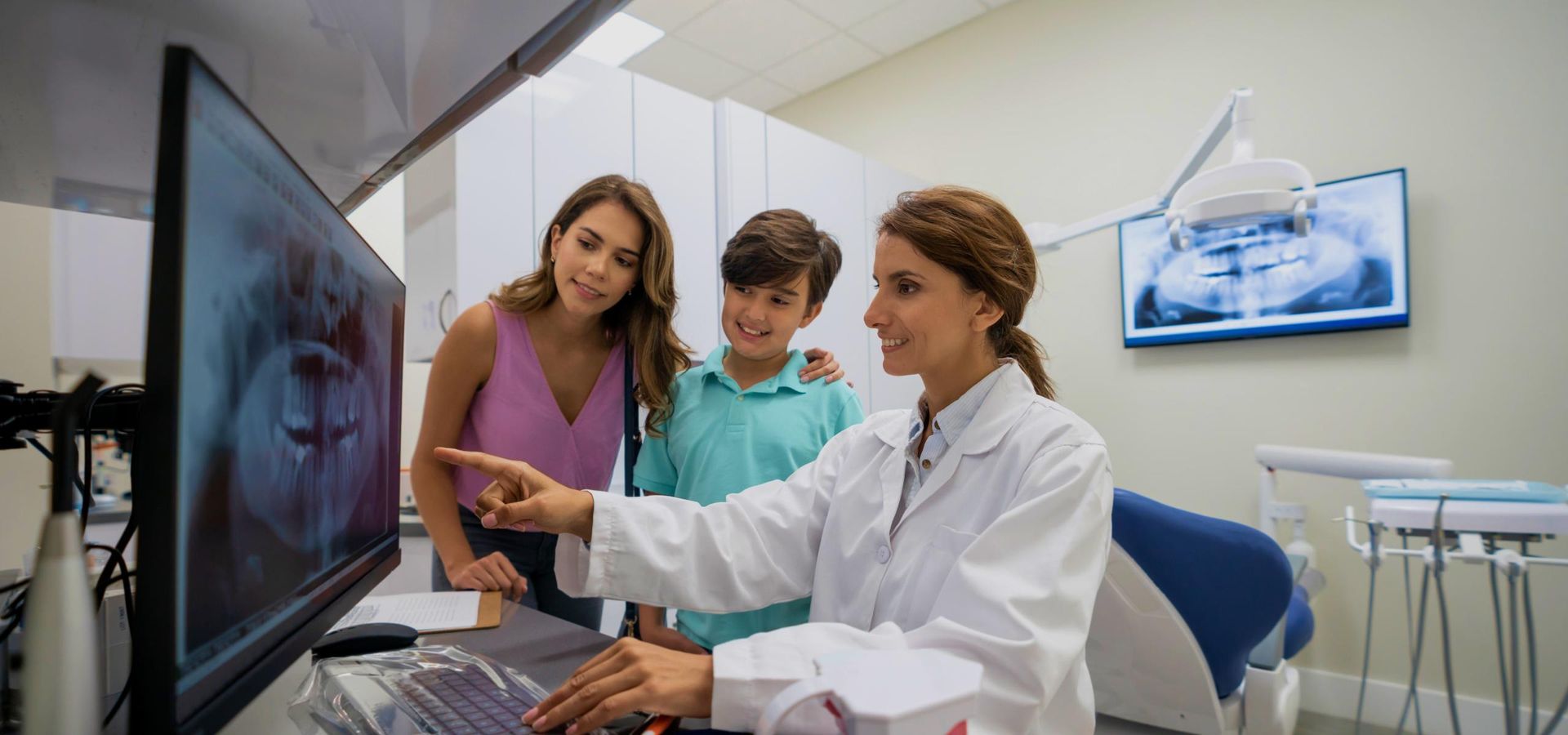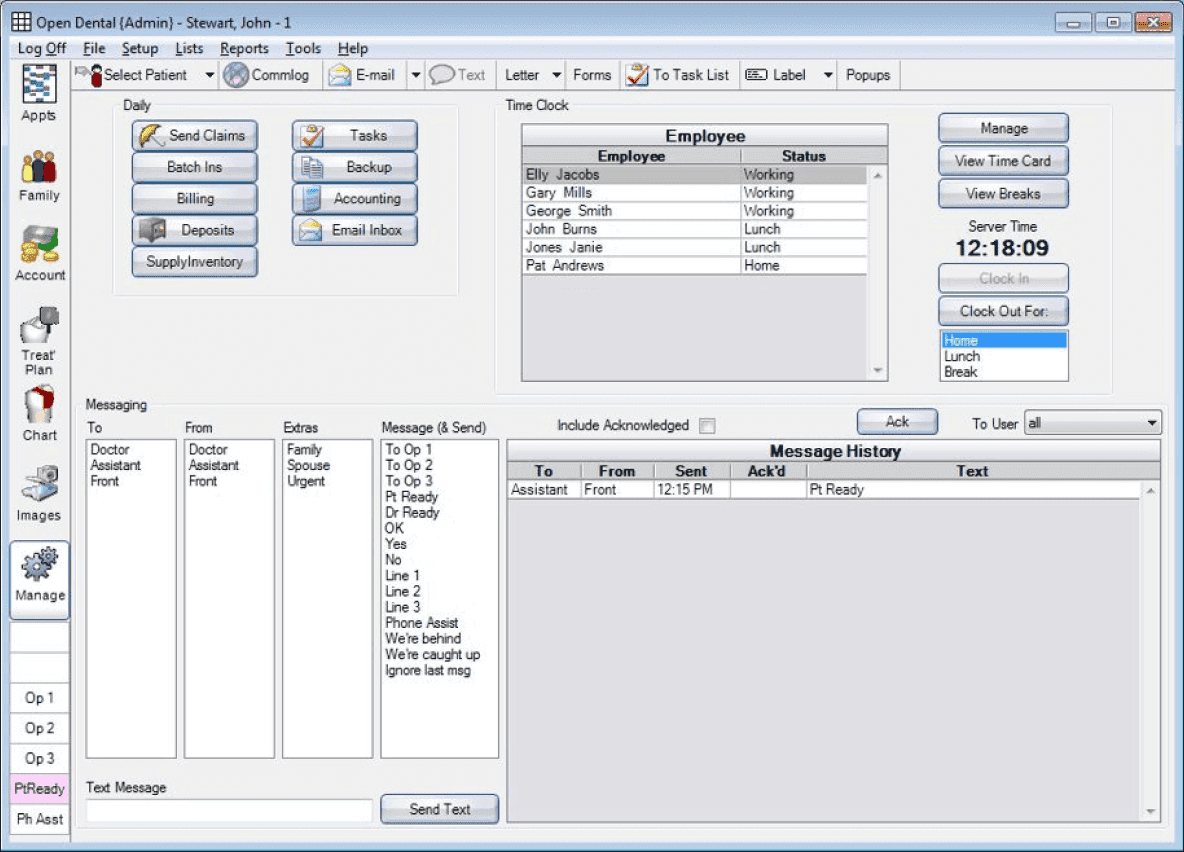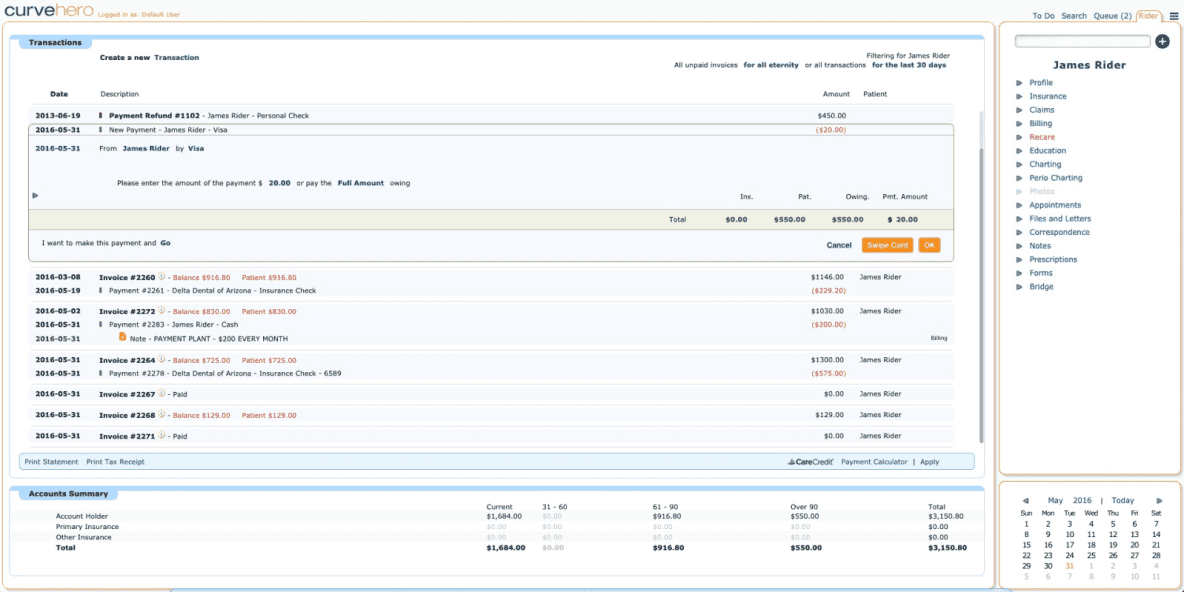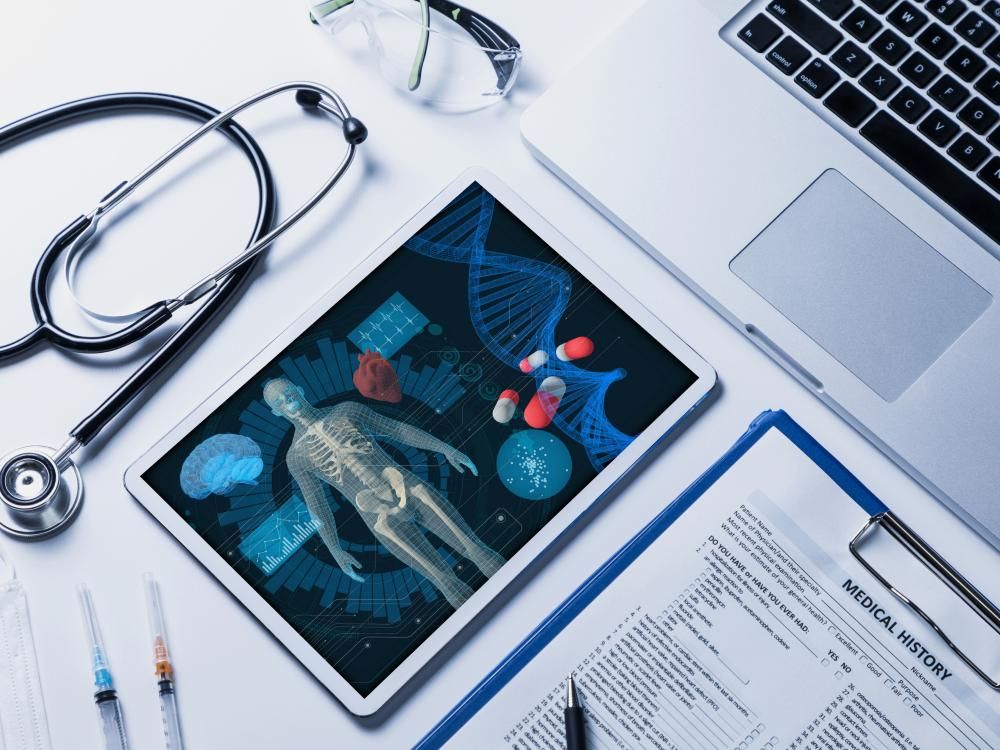
Dental EHR: main features, integrations & best practices
July 13, 2023
Dentistry is often distinguished from other medical practices: it is taught separately, has unique standards and regulations, and falls under its own type of insurance. Naturally, dentists require highly specialized healthcare software, which includes electronic health records.
Electronic dental records (EDR) is a type of EHR used by dental practices. It securely stores patient data in a structured format that can be easily accessed by designated users and transferred to other healthcare systems.
Dental EHR market stats
of dentists used EHR in their practice in 2021
Maryland Healthcare Commission
CAGR of the dental practice management software market from 2021-2027
Global Market Insights
projected dental practice management software market size in 2027
Statista
Main features of dental EHR
There are multiple dentistry-specific EHRs on the market, and practitioners can buy a license for a proprietary system or install an open-source EHR. Regardless of the cost, an effective EDR usually comprises the following features:

Core EHR features
Dental EHRs have the same basic features as a general-use system:
- Complete medical and dental health history
- Patient profiling
- Appointment scheduler and reminder
- Comprehensive dashboards with medical information
- Multi-factor authentication
- Different levels of distributed access control
- Data encryption
- Secure data transfer channels and protocols
- E-prescriptions
Optional features
Depending on the practice specifics and size, EDRs may have additional features:
- Patient portal integration
- Symptomatic pattern identification
- Health condition forecasting
- Department productivity evaluation
- Task trackers and reminders
- Voice recognition
- Chatbots and voice assistants
- Referrals management
Dentistry-specific features
It is crucial for an EDR to have field-specific features:
- ICD/CPT codes specific to dentistry
- Periodontal charting
- Integration with dental imaging systems
- Integration with dental medical devices
- Treatment planning
- Dental billing and insurance
- Dentistry-specific templates for documenting procedures
- Implant tracking
Elevate your quality of care with our EHR development services
Dental practice EHR integrations
Healthcare organizations are digitizing most clinical operations, not only medical history records. Thus, for dental EHR software to bring the most advantages to a practice, it should streamline as many routine workflows as possible. Organizations can achieve this by flawlessly integrating dentistry-specific systems with other software they use every day.
Streamline admin tasks such as patient check-in while distributing resources more effectively according to the current clinical situation reflected in the EHR by connecting it to dental PMS.
Improve health management for patients with complex health conditions by enabling secure data exchange between dental and general healthcare providers.
Improve patient experiences by enabling them to manage their dental records, schedule appointments, receive reminders, view educational materials, and communicate with dental professionals via connected patient engagement tools.
Revenue cycle management software
Boost revenue by automating billing, insurance claim management, and reimbursement tracking with the help of integrated RCM software.
Laboratory management software
Request and receive accurate lab test results faster via the connection of dental EHR and LIS.
Analyze X-rays, CT scans, and other dental images stored in the EHR to diagnose, predict, treat, and monitor dental conditions more effectively.
Reduce errors in medication management and streamline orders by sending electronic prescriptions directly from EHRs to pharmacy software.
Facilitate virtual dental consultations and remote patient monitoring by giving clinicians access to accurate patient information via the EHR-connected telehealth platform.
On-premises vs cloud dental EHR
Dental care providers adopting EHR choose between two modes of software solution deployment: on-premises or cloud. Each type has its own advantages and limitations, and the choice depends on the particular dental practice’s requirements.
Cloud
On-premise
Set-up
Set-up
Doesn’t require profound hardware and infrastructure changes: easier and faster to set up
Takes time and requires hardware, workflows, and infrastructure changes
Cost
Cost
Lower upfront fees but higher lifetime costs
Higher initial payment but lower lifetime costs
Accessibility
Accessibility
Patient health data is accessible from anywhere via the internet
Patient health data is accessible online and offline from the dental practice’s facilities
Security
Security
Targeted by cyber attacks more frequently and needs more security measures
Usually more protected from internet cyber attacks but sensitive to internal security threats
Reliability
Reliability
Data is backed up on servers outside the facility and protected by vendors
Dental care providers are responsible for backups and data recovery
Customization
Customization
Can be customized quickly but with limited options
Takes longer to customize but can be tuned more accurately to the particular organization’s needs
Tips on choosing and implementing dental EHR software
With so many systems to track dental records, deciding which works best for your practice can be challenging. To sort this out, consider the following:
Ensure compliance with healthcare regulations
Map out the workflows
Create a comprehensive roadmap
Make improvements after users’ feedback
Train your personnel
Migrate data accurately and securely
Ensure data safety and security
Involve dental specialists
Successful EHR implementation
1 The size of your practice
Some solutions with numerous features, robust customer support, many add-on modules, and expensive pricing plans are better suited for large enterprises. Cheaper systems with basic functionality, a simple interface, and requiring less storage space can better fit small and middle-sized dental practices.
2 The required feature set
Some practitioners are happy with out-of-the-box solutions, while others need specialized orthodontics, pediatric dentistry, oral surgery, and prosthodontics modules. If this is your case, think about a custom EHR solution. Discuss the future solution’s compliance with the development team to avoid unpleasant surprises.
3 Hardware, software, and network
Ensure your EHR works on your devices and integrates well with the healthcare IT ecosystem at your organization. Check if your network will be able to support your new solution. Your deployment model of choice might depend on the state of your network, as a cloud-based one requires stellar connectivity.
Dental EHR implementation roadmap
Our experts support dental care professionals throughout all stages of dental EHR adoption, providing consultation, development, tuning, integration, data migration, and post-deployment support services.
1
Preparation
- Define main EMR/EHR requirements and tech stack
- Map out crucial workflows and outline main project milestones
- Work out a data governance strategy to ensure effective and sustainable system adoption
2
Implementation
- Develop EHR/EMR software or tune the existing system according to your practice’s needs
- Integrate your other healthcare software
- Migrate data from one system to another if needed
- Perform all-round quality assurance and ensure security and meaningful use requirements are met
3
Post-deployment
- Monitor the system’s performance
- Resolve any issues that come up
- Update and upgrade the system if needed
- Train your personnel
Top dental EHR solutions
Open Dental
Open Dental is the largest open-source practice management solution that includes dental EMR, e-Prescribing (e-Rx), imaging, and financial imaging modules. This software is highly customizable, reasonably low-cost, and has powerful charting, treatment planning, and patient engagement capabilities.
Image title: Open Dental system screenshot
Data source: emrsystems.net — Open Dental Software, 2023

Features
- Patient profiling
- Charting
- Appointment scheduling and reminders
- E-prescribing
- Treatment plan templates
- Image storage and viewer
Additional modules
- Patient portal
- Billing module
- Integrations with other hospital software
Deployment
- On-premise
- Cloud-based
Cost
- $179/month/location in the US
- Varies depending on the country
Customer support
- Via online chat
- Via phone call
Compatible OS
- Windows XP
- Windows 8
- Windows 10
- Mac OS
Best suited for
- Small to large-sized dental practices
Dentrix Ascend
Dentrix Ascend is a practice management system belonging to the larger family of Dentrix dental software. It has robust charting and image-viewing capabilities, a relatively intuitive interface, and an open API that can be used to add customizations to the core product. However, it is quite expensive for smaller practices, and its patient engagement module has limited functionality.
Features
- Patient profiling
- 3D clinical charting
- Image viewing
- Analytics and reporting module
- E-prescribing
- Treatment plans
- Claim management
Additional modules
- Revenue cycle management module
- Patient communication tools
- Marketing tools
Deployment
- Cloud-based
Cost
- $700/month
Customer support
- Via email
- Via online chat
- Via phone call
Compatible OS
- Microsoft Windows 10 or Windows 11
- MacOS X 10.13 or later
- iOS 12 or later
Best suited for
- Large-sized organizations
Curve Dental
Curve Dental is a cloud-based, easy, dynamic, and secure EHR and practice management software. Its advantages include a clean and modern interface, powerful dental charting, and superior image analysis capabilities. Curve Dental consists of different modules which can be installed together or separately depending on the practice's needs, which means it is flexible and affordable for smaller dental practices.
Image title: Curve Hero dental EHR screenshot
Data source: emrsystems.net — Curve Dental EHR Software, 2023

Features
- Appointment and claim management
- Charting
- Inventory management
- Patient account management
Additional modules
- Patient engagement
- Imaging
- Financial management
Deployment
- Cloud-based
Cost
- From $350/month for each dentist
Customer support
- Via email
- Online chat
- Phone call
Compatible OS
- Windows 8
- Windows 10
- Mac OS X Sierra or newer
Best suited for
- Small organization
- Mid-sized organization
Microsoft Cloud for Healthcare is a platform configured for the healthcare industry offering powerful data management, patient engagement, team collaboration, and analytical capabilities. Using Microsoft Cloud for Healthcare as a base platform, healthcare organizations can create high-performing, interoperable, secure, and compliant dental EHR solutions.
Features
- Patient profiling
- Patient portal
- Personalized care plan creation and management
- Patient data management and analysis
- Video conferencing tools
- Azure Health Bot
Additional modules
- Revenue cycle management module
- Sales and marketing tools
- Healthcare BI
Deployment
- Cloud-based
Cost
- Depends on a combination of features
Customer support
- Via email
- Via online chat
- Via phone call
Compatible OS
- OS-agnostic
Best suited for
- Mid-sized organizations
- Large-sized organizations
Custom dental EHR
Our experts specialize in developing and fine-tuning custom EHR solutions to fit the exact needs of the particular practice. We create a system with functionality essential to your practice and a personalized interface to eliminate the risk of burnout for dentists and flatten the software learning curve. After we integrate the solution into a hospital ecosystem, facilitating data flow between different software, our support team monitors the system’s performance and can upgrade or update it upon request.
Ready to boost the performance of your dental practice?
Benefits of EHR in dentistry
Electronic health records software brings very tangible benefits to both clinicians and their patients.
Enhanced coordination with a patient’s medical provider
Every medical specialist should know a patient's full health history (possible allergies, medication adherence, and chronic conditions) to prescribe an optimal treatment course. Therefore, EHR interoperability is crucial in healthcare. A study conducted among medical and dental professionals representing U.S. dental schools and a foreign university hospital showed that 68.5% of providers had at least one case when access to corresponding health information could have improved diagnostic accuracy and treatment.
Scheme title: Medical information that the physician (MD) would want the patient's dentist (DMD) to access versus medical information that the dentist would like to access in an integrated EHR.
Data source: ncbi.nlm.nih.gov—Improving Oral–Systemic Healthcare through the Interoperability of Electronic Medical and Dental Records: An Exploratory Study, 29 May 2019.
Increased revenue
Any practice with improved efficiency will ultimately increase its revenue by cutting costs on routine tasks and eliminating the need to pay overtime to staff. However, EDR helps make dental practices even more profitable. Integrated practice management, billing, and insurance modules ensure quicker bill turnaround: the cost can be calculated automatically depending on the procedures provided during the patient’s visit. Then the bill can either be covered by insurance without inputting the patient’s details twice into different systems or paid by the patient without hassle.
The software has streamlined my office’s insurance claim processing. Claims are filed immediately after each visit. Even complex claims are submitted quickly and easily. The software is continually improving.
Dr. Eli Z
Improved organizational efficiency
A good EDR enables specialists to do more in less time. It spares dentists the necessity to fill in multiple patient profile forms at the beginning of a patient's visit, shuffle through the paper records to understand their medical history, or manually shade the periodontal charts. Today, all medical and dental info is either accessible from one place with one click or can be input into the system very quickly thanks to pre-made templates.
Elevated accuracy and quality of care
Dental providers with less routine clinical and administrative tasks have more energy and time for patients. Access to patients’ electronic medical records, lab results, and dental images enables them to provide faster and more personalized patient care. Applying analytical tools to data stored in EDR gives dental professionals an opportunity to predict possible patient outcomes and prevent potential issues in advance. Moreover, improved dental care contributes to patients’ overall well-being: studies published in the journal of ethics suggest that it can be a positive factor in managing such serious conditions as diabetes.
Better data protection
Paper patient records stored in a text file on the practitioner’s computer are easily compromised and lost. EHRs that are secure by design, and follow all healthcare industry standards like OWASP and HIPAA, keep patients’ information protected from malicious acts. A cloud-based EHR ensures patients’ medical and dental histories are safe as the information is not stored only at the organization’s on-site servers but backed up in the cloud.
No more worrying about backups, my EHR keeps it in the cloud. I can access my schedule from anywhere.
Dr. Paul Yeung
Paul Yeung, DDS
Overcoming dentistry EHR-related challenges
A dentistry-specific system implementation can go differently than one would hope. Going into this journey without a proper understanding of the process could be challenging for a dental care provider. However, experts recommend a few tricks to ensure successful EHR implementation.
Challenge
Solution
Reluctance to change
Reluctance to change
One of the main reasons the EHR adoption rate in dentistry is low is not enough motivation for personnel to use it. Dentists might not want to change their usual workflows and adapt to new software.
Prepare the ground for change beforehand. First, the leader should state why the change is needed and what the updated workflows will look like. Then, personnel should be able to ask questions and make suggestions regarding future changes, which makes them invested in the process. Dedicated training must clear up any remaining doubts.
High cost
High cost
Some dental service providers, especially small or solo practitioners, can’t afford the most popular electronic health records solutions if they require payment upfront.
There are a lot of differently-priced systems, including free software that is monetized by showing ads, open-source solutions, or EHR platforms that charge patients for using the service instead of practitioners.
EHR-associated burnout
EHR-associated burnout
Many specialists worry that the EHR system will add to their workload, requiring them to fill out more fields or work overtime.
The EHR system adoption depends on its usability. The system, which fits the dental practice's clinical needs, improves workflows, has a user-friendly interface, and is integrated with other software, will be more likely welcomed.
Become an industry innovator with dental EHR
Dentists and other oral health specialists need specialized EHRs to increase revenue, enhance practice efficiency, and better health outcomes. If you want to get ahead of the competitors and provide enhanced services to your patients with the help of a dental EHR, the Itransition team will help you choose the optimal solution that fits your practice or develop a custom one.
Our experienced EHR consultants and developers will ensure its compliance with all regulations, integrate it with the existing systems, migrate the data from your current system, and conduct personnel training for you to get the most benefits out of your software.

Service
EMR/EHR software development: a comprehensive guide
Discover the major capabilities and use cases of EHR systems and learn how we can support your organization with EMR/EHR software development services.

Case study
Telemedicine-ready EHR
Development and testing of a Telemedicine-enabled EHR, integrated with innovative voice recognition, smartpen and clinical text analysis features.

Insights
EHR implementation strategy: key steps, approaches & challenges
Discover an actionable electronic health records implementation plan to help you successfully adopt EHR software, increasing your organization’s productivity.

Insights
EHR integration: a complete overview & real-world examples
Explore EHR integration payoffs, roadmap, and real-life examples, as well as healthcare software to integrate with EHRs to improve care quality.

Insights
Open-source EHR: functionality, benefits and limitations
Should you choose an open-source EHR? Learn about the key features of open-source EHRs, as well as the pros, the cons and popular platforms to make a decision.
More about healthcare software services
Services
- Healthcare software development
- Healthcare mobile app development
- Patient portals
- Hospital management software
- Hospital inventory management software
- CRM
- Data analytics
- Remote patient monitoring
- Medical image analysis
- Pharmacy management software
- Medical device software development
- Patient engagement solutions
EHR
Telehealth